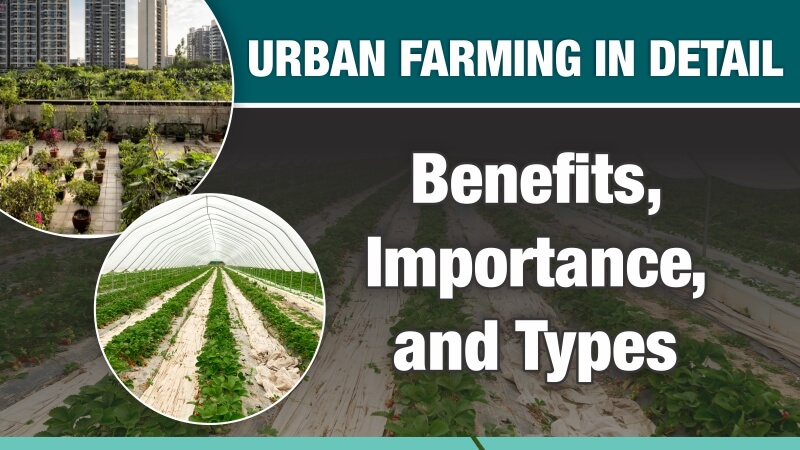The goal of urban farming, sometimes known as urban agriculture, is to grow food within the boundaries of cities. Although it presents certain difficulties, it also has numerous advantages, including improved food security, reduced waste, community involvement, and more.
Community gardening, homesteading, and subsistence farming is sometimes confused with urban farming. Simply speaking, urban farming places more of a focus on producing food to be sold rather than for individual consumption or sharing. In other words, Growing, processing, and distributing food in or near urban areas is known as urban agriculture, urban farming, or urban gardening. In many cities in both wealthy and developing nations, it includes a complex and varied mix of food-producing activities, including forests and fisheries. Animal husbandry, aquaculture, urban beekeeping, and horticulture are also included under the phrase “urban agriculture.” These activities also take place in peri-urban locations.
Food is made in an urban area and sold to consumers there as part of a local food system, or urban agriculture. Animal husbandry (such as breeding and raising animals), beekeeping, aquaculture (such as fish farming), aquaponics (such as combining fish farming and agriculture), and production of non-food items like seeds, seedlings, and flowers are also examples of urban farming. Urban farms can also take measures to improve vacant or unused urban land, assist urban communities’ social and economic well-being, and improve the appearance of urban areas.
Benefits Of Urban Farming:
There are many advantages to urban farming over traditional farming. Some of them might be simple to understand:
- Most needy low-income people can get food from urban farms. Healthy and fresh food are produced in urban areas closer to where it will be consumed. Less food will have to travel farther, which is wonderful for reducing carbon emissions and halting climate change.
- Food grown in metropolitan areas is much more likely to be in-season, perfectly ripe, and nutritious. Fruits, vegetables, and herbs all qualify.
- Urban farming enables the utilization of land that might otherwise be unwanted or unusable. An urban farm gives aging, run-down neighborhoods fresh life.
- It increases the amount of green space, which cities may be in dire need of. Compared to an empty property, greenery has a more aesthetically pleasing effect on the area.
- It’s an opportunity to learn new gardening skills and information that other people might not have experienced.
- Lower Investment Needed: Purchasing a traditional farm is a significant endeavor. Even a tiny farm with a couple of acres will cost you hundreds of thousands of dollars. Even renting acreage from another farmer for a season will cost you a fair bit of money.
Importance of Urban Farming:
- Urban farming offers those who may not be able to leave the city and purchase a rural plot of land the possibility to follow their passion for agriculture either for practical, logistical, or monetary considerations.
- Urban farms can sell their products via farmer’s markets, directly to restaurants or supermarkets.
- There is a rising demand for locally grown, environmentally friendly, organic produce as people become more knowledgeable about their food, where it comes from, and how food transportation may contribute to climate change.
- On rooftops, next to restaurants and other businesses, in backyards, at schools, next to apartment complexes and condos, in public places and parks, and wherever else you may think of.
- Therefore, people have developed a wide range of original techniques for urban farming that are effective in a wide range of various circumstances and situations.
There are different types of Urban Farming, some of them are listed below:
- Vertical Farming:
Crops are grown vertically in layers that are placed one on top of the other. Growing against walls or fences on pallets that have been carefully converted or on shelving can achieve this.
Vertical farms can be situated inside structures, in shipping containers, or in other underground tunnels like abandoned holes in the ground. It is commonly used in combination with other advanced methods like aquaponics or hydroponics in a climate-controlled setting.
Given that many plants don’t require a lot of vertical room to thrive, vertical farming can significantly increase the amount of food that can be produced per square foot of space.
You can suddenly grow 300 to 400 percent more plants than you could normally put in the same amount of space if you can stack three or four shelves of plants on top of one another.
- Hydroponics:
Any method for growing plants without soil is known as hydroponics. Instead, water that plants are submerged in or that frequently washes over their roots is supplemented with nutrients.
To provide the plants with more physical support, use gravel, perlite, or other materials. Chemical fertilizers or organic stuff like manure can be used in hydroponic systems. Hydroponic systems can reduce the amount of water needed to grow crops because water is recycled and reused in them.
- Aquaponics:
Any method that combines hydroponics and conventional aquaculture farming fish or other marine life is an aquaponic system. Fish and plants have a symbiotic interaction as a result.
Fish consume food and expel ammonia. Ammonia in the water is converted into nutrients for the plants by helpful microorganisms.
The nutrients operate as a kind of organic fertilizer by being absorbed by the plants. In order for the cycle to continue, water is continuously recirculated through the system.
- Backyard Gardens:
They do not really take up much room, so you can squeeze one practically anyplace.
one can actually generate a full-time income using urban farming techniques on a plot of land as little as 1/3 to 1/4 of an acre. Backyard gardens are another name for backyard farms.
The majority of people’s yards lie empty, and keeping them up and cutting the grass can be more of a chore than anything else. Most individuals are more than willing to let you grow food in their backyards in exchange for a share of your crop or the money you make. Other individuals might rent you the space for a fixed price per season.
- Rooftop Farming:
If there is any green space accessible at all in the center of the city, it is expensive.
Raised beds and greenhouses on rooftops are all potential solutions. Everything depends on the use of the space that the building owner is satisfied with, as well as the legislation in your area.
Before beginning a rooftop farm, caution should be given to ensure that there is sufficient support in place. Before beginning a rooftop farm, caution should be given to ensure that there is sufficient support in place.
When compacted, soil can weigh thousands of pounds, thus rooftop farms must be carefully designed to ensure the roof can withstand the weight.
For more blogs related to Farming and other agricultural practices, visit the Khetigaadi blog section for more details.
For additional updates on the agriculture sector, check out the Khetiguru mobile app.




